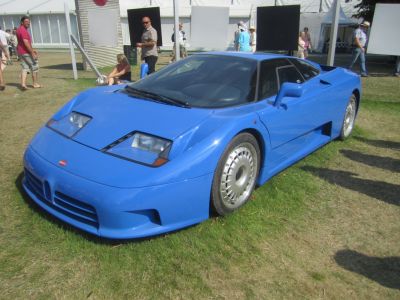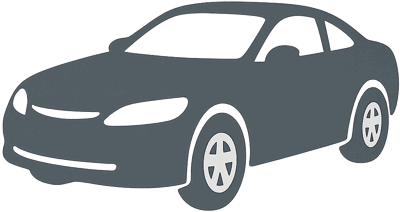 2005 Bugatti Veyron Coupe Dimensions, Size & Specs
2005 Bugatti Veyron Coupe Dimensions, Size & SpecsMeasurements of the 2005 Bugatti Veyron Coupe, engineered for optimal performance and comfort
| Dimensions | |
|---|---|
| Length: | 4462 mm175.7 in14.6 ft |
| Width: | 1998 mm78.7 in6.6 ft |
| Height: | 1190-1204 mm46.9-47.4 in3.9-4.0 ft |
| Weight Specifications | |
| Curb Weight: | 1838-1888 kg4052-4162 lbs |
| Maximal permitted Weight: | 2200 kg4850 lbs |
| Tire Specifications | |
| Rims Sizes: | 20-inch rims:
|
| Tire Sizes: |
|
The Bugatti Veyron Coupe, produced from 2005 to 2011, is an iconic supercar that combines extreme performance with luxurious design. As a two-door coupe, it commands attention not only for its exceptional power but also for its remarkable dimensions and engineering precision. Measuring 4462 mm (175.7 inches) in length, 1998 mm (78.6 inches) in width, and standing between 1190 mm to 1204 mm (46.9 to 47.4 inches) in height, the Veyron Coupe offers a low, wide stance that enhances both its aerodynamics and road presence.
With a curb weight ranging from 1838 to 1888 kg (4,052 to 4,162 lbs), the Veyron balances its massive engine and advanced technology with lightweight construction techniques to optimize handling and acceleration. The maximum permissible weight for the vehicle is 2200 kg (4,850 lbs), reflecting the high-performance materials and components used throughout. Its wheels are sized at 10J x 20 inches for the front and 14J x 21 inches for the rear, fitted with specialized tires in sizes 265/35 ZR20 and 365/25 ZR21, respectively, as well as additional specialized tire specifications like 265/680 ZR 500A and 365/710 ZR 540A, ensuring optimal grip and stability at high speeds.
This coupe’s dimensions and technical specifications contribute to its reputation as one of the fastest and most technologically advanced production vehicles ever built. When compared to other supercars in its class, the Bugatti Veyron Coupe’s combination of size, weight, and tire technology illustrates how it achieves its unmatched performance without sacrificing drivability or luxury. Whether for collectors, automotive enthusiasts, or those comparing the dimensions of iconic coupes, the Veyron stands out for its meticulous balance of engineering excellence and aesthetic refinement.
Discover the standout features that make the 2005 Bugatti Veyron Coupe a leader in its class
Have a question? Please check our knowledgebase first.
The Bugatti Veyron Coupe measures 4462 mm (175.7 inches) in length, 1998 mm (78.6 inches) in width, and its height ranges between 1190 mm to 1204 mm (46.9 to 47.4 inches). These dimensions give the Veyron a wide and low-slung stance, contributing to its aerodynamic efficiency and aggressive appearance. The width includes the car's wide body and tires, essential for handling the immense power it produces. The height adjustment range depends on specific versions or suspension settings, but overall, the Veyron's dimensions reflect a very performance-focused supercar built for high-speed stability and presence.
The Bugatti Veyron Coupe's curb weight ranges from 1838 kg to 1888 kg (4052 to 4163 pounds), depending on specific model variants and equipment. The maximum allowable weight for the vehicle is 2200 kg (4850 pounds). Despite being built for extreme performance with a massive 8.0-liter W16 engine and high-tech components, the construction uses lightweight materials to keep the weight relatively low for such a powerful supercar. However, the car still carries heavyweight due to its robust drivetrain, large brakes, and luxury features, balancing performance with safety and comfort.
The Bugatti Veyron Coupe's dimensions, particularly its width of 1998 mm (78.6 inches) and height around 1200 mm (47 inches), make it a relatively wide and low vehicle. Most standard home garages have widths ranging from about 2400 mm to 2700 mm (94.5 to 106 inches), so technically the Veyron fits in terms of width, but with limited lateral clearance. The low height also means there are no issues with vertical clearance in standard garages, which usually have heights well over 2100 mm (82.7 inches). However, due to the Veyron’s rarity, value, and width, careful maneuvering is always recommended when parking in a typical home garage.
The Bugatti Veyron Coupe, introduced in 2005, dramatically changed the scale versus any prior Bugatti models, as it was a new modern supercar representing a quantum leap from the classic and pre-war Bugatti cars. Earlier Bugattis like the EB110 (1991-1995), which can be considered its closest predecessor in spirit, were smaller: the EB110 measured about 4450 mm (175 inches) in length, had a narrower width (~1900 mm), and was similarly low in height. The Veyron is wider and slightly longer, with much more emphasis on aerodynamic stability, accommodating a larger and more complex engineering layout, including its quad-turbo W16 engine, which required a bigger chassis for performance and cooling.
The Bugatti Veyron Coupe features highly specialized rim and tire sizes to handle its extreme performance. The rims come in two sizes: 10J x 20 inches at the front and 14J x 21 inches at the rear, reflecting a staggered setup with broader rear wheels to maximize grip. Correspondingly, the front tires measure 265/35 ZR20, while the rear tires are 365/25 ZR21. Additionally, specific racing or performance tires include sizes such as 265/680 ZR 500A and 365/710 ZR 540A. These wide, low-profile tires and large rims provide the necessary contact patch, high-speed stability, and heat dissipation required for a car capable of speeds over 400 km/h (249 mph). This setup ensures the Veyron's handling precision and safety at extreme speeds.
During its production from 2005 to 2011, the Bugatti Veyron Coupe stood out with its impressive dimensions: 4462 mm long, 1998 mm wide, and about 1200 mm tall. Compared to rivals like the Ferrari Enzo (length 4633 mm, width 1974 mm, height 1141 mm) and the Lamborghini Murcielago (length 4792 mm, width 2030 mm, height 1135 mm), the Veyron is slightly shorter than the Murcielago but wider than both, emphasizing stability. Its height is similar but tends to be slightly taller, providing a unique footprint that balances aerodynamics with mechanical space. The Veyron's wide stance and distinct size were engineered to support its unprecedented power and speed capabilities, setting it apart visually and dynamically in the supercar segment.
The Bugatti Veyron Coupe’s height range from 1190 mm to 1204 mm (46.9 to 47.4 inches) reflects some variation due to suspension settings or minor model-specific adjustments. This low profile is crucial for aerodynamics, reducing drag and improving high-speed stability. The small height minimizes frontal area, which helps the car slice through air efficiently, enabling it to achieve top speeds over 400 km/h (249 mph). Additionally, a low center of gravity derived from this low height improves handling precision, cornering grip, and driver feedback, crucial for a high-performance supercar. Even slight changes in height affect downforce and airflow management at speed, demonstrating Bugatti's attention to detail in aerodynamic tuning.
Although the Bugatti Veyron Coupe has relatively compact exterior dimensions for a supercar, it is designed as a two-seat coupe with a focus on high performance and luxury rather than spaciousness. The interior accommodates two passengers comfortably, with high-quality materials, advanced controls, and a cockpit styled for driving engagement. The compact length of 4462 mm (175.7 inches) and width of 1998 mm (78.6 inches) prioritize streamlined aerodynamics over interior volume, and the low height limits headroom slightly but remains sufficient for most drivers and passengers. Storage space is minimal and intended primarily for essentials rather than luggage, consistent with its supercar role.
The Bugatti Veyron Coupe’s size and weight reflect its identity as an extreme performance machine rather than a daily driver. With a curb weight between 1838 and 1888 kg (4052 to 4163 pounds), the car is heavier than typical sports cars due to its all-wheel-drive system, massive W16 engine, and robust drivetrain components. Its wide dimensions can make maneuvering in tight urban environments challenging, and the low ground clearance combined with wide tires means that care is needed on uneven or rough roads. While the Veyron is equipped with luxury features for comfort and safety, its supercar setup prioritizes track and high-speed driving over everyday practicality, making it more suited for enthusiasts and collectors.
When compared to other sports cars from the same era such as the McLaren F1, Ferrari Enzo, or Lamborghini Murciélago, the Bugatti Veyron Coupe is generally wider and heavier. For instance, the McLaren F1 measures approximately 4288 mm in length and 1820 mm in width and weighs around 1140 kg (2513 pounds), noticeably lighter and more compact. The Ferrari Enzo has a length of 4633 mm and weighs about 1365 kg (3008 pounds), and the Lamborghini Murciélago is larger at 4792 mm length and 1700+ kg weight. The Veyron’s width of nearly 2 meters and weight close to two tons reflect its emphasis on stability and luxury, standing out as a differently focused engineering feat emphasizing raw power and advanced technology over minimalism and lightness.
Discover similar sized cars.

| Production: | 1991-1996 |
|---|---|
| Model Year: | 1992 |
| Length: | 4400 mm173.2 in |
| Width: | 1940-1960 mm76.4-77.2 in |
| Height: | 1125 mm44.3 in |

| Production: | 1996-1999 |
|---|---|
| Model Year: | 1996 |
| Length: | 4450 mm175.2 in |
| Width: | 1990 mm78.3 in |
| Height: | 1190 mm46.9 in |
